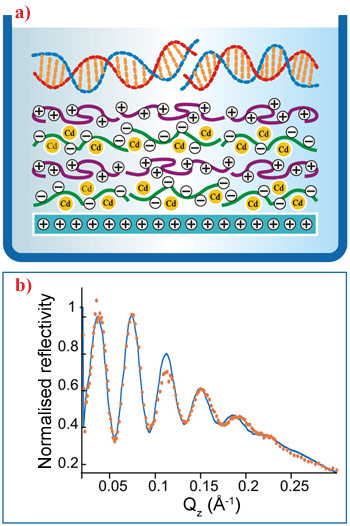- Home
- News
- Spotlight on Science
- Layer-by-layer films...
Layer-by-layer films at the solid/liquid interface studied by X-ray reflectivity
12-11-2008
Decoration of layer-by-layer films with heavy metal ions permits their study by X-ray reflectivity and interpretation of their structure for the first time.
Share
Thin films of polyion organic layers on solid supports can be produced with nanometre precision by polyelectrolyte self-assembly. These layer-by-layer (LbL) films have various applications including facilitating the manipulation of biological molecules such as DNA [1]. The study of their structure in a liquid environment like that of biological systems is very important because it could reveal their organisation under working conditions. However, the low contrast between such layers and water makes it very difficult to obtain good quality X-ray scattering data. In this work we have demonstrated a method to increase the electron density contrast between the deposited layer-by-layer films and the surrounding water thus allowing the study of the LbL film structure while immersed in the liquid phase. The method is based on the inclusion (“decoration”) of heavy metal ions into the layer. X-ray reflectivity (XRR) curves at solid-liquid interface were measured with high energy X-rays at ESRF beamline ID10B where is was possible to obtain reliable experimental data with acceptable signal-to-noise ratio. This approach was then applied to study the interaction of DNA molecules with preformed LbL multilayers, investigating the resulting molecular structure for both double stranded (dsDNA) and single stranded (ssDNA) DNA.
Samples were formed on silicon substrates with a first deposited layer of poly(ethyleneimine) (PEI). The remainder of the film then consisted of alternating layers of poly(allylamine hydrochloride) (PAH) and poly(sodium 4-styrenesulfonate) (PSS). Decoration was performed by the deposition of the final 3 bilayers from a 0.25M CdCl2 solution.
XRR of the control samples without decoration revealed a smooth, featureless curve excluding any reliable fitting and interpretation – this was expected. Experimental curves were much more informative when investigating the samples prepared from cadmium salt solutions of polymers. The XRR measurements were sufficient to determine the thickness and to establish a model taking into account water, the LbL film and silicon. They also confirmed that no ions were released back into the aqueous solution.
The characterised layers were then used as substrates for subsequent DNA deposition. A model for the layer organisation as well as experimental XRR data, together with best fit for the double-stranded DNA with the sample, are presented in Figure 1.
Layer-by-layer film decoration has permitted the first X-ray reflectivity measurements at the solid/liquid interface that afford reliable interpretation and modelling. Ions incorporated into the film are rather strongly bound. This is very important for experiments where the presence of heavy ions in solution is not desirable. Therefore, only the sublayer must be decorated, while successive layers of biological molecules can be formed from solutions free from heavy metal ions. In fact, model biological systems have confirmed the validity of the approach. DNA layers were deposited from aqueous solutions and were not exposed to heavy metal ions, which could cause some structural variations. This new approach, together with an already reported neutron reflectivity method [2,3], will be even more important for studying protein-containing films in their natural environment.
References
[1] Y.M. Lvov, Z. Lu, J.B. Schenkman, X. Zu and J.F. Rusling, J. Am. Chem. Soc. 120, 4073 (1998).
[2] A. Plech, T. Salditt, C. Munster and J. Peisl, J. Colloid Interface Sci. 233, 74 (2000).
[3] D. Carriere, R. Krastev, and M. Schonhoff, Langmuir 20, 11465 (2004).
Principal publication and authors
(a) S. Erokhina (a), T. Berzina (a,b), L. Cristofolini (a,b), V. Erokhin (a,b), C. Folli (a), O. Konovalov (c), I.-G. Marino (a), M. P. Fontana (a,b), X-ray reflectivity measurements of layer-by-layer films at the solid/liquid interface, Langmuir 24, 12093 (2008).
(a) University of Parma (Italy)
(b) Centro SOFT CNR-INFM (Italy)
(c) ESRF




